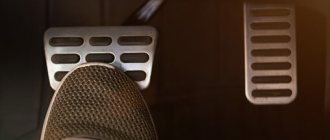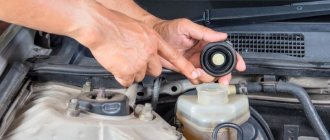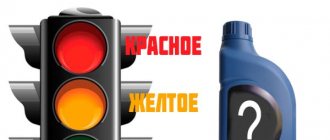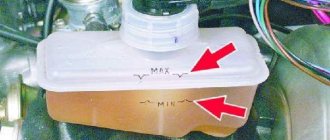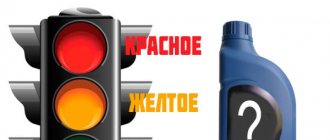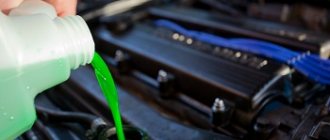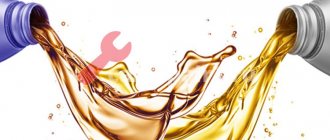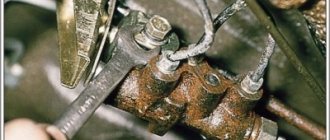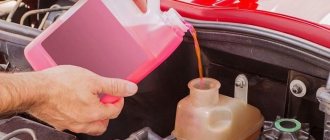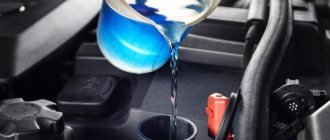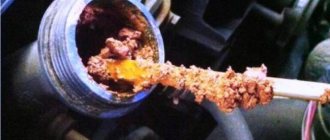Hello again, friends, today I will share useful information about mixing brake fluids. Often you don’t know or don’t remember what kind of fluid was poured into the brake reservoir. And the time has come to top up or change it. If it's time for you to change the fluid, read my article on replacing brake fluid yourself.
But this article will help you top it up correctly. Is it possible to mix brake fluid when adding brake fluid to the reservoir when there is not enough old? What will happen? What are the dangers of mixing? Which ones are allowed to be mixed? Is it worth listening to the advice of the “crazy people”, “Kulibins” and other craftsmen to spoil their own and other people’s cars? I'll tell you now.
What are there
I'll start with the types (varieties) of brake fluids, there are not so many of them, but still should not be confused:
- I also found BSK - it was used in old GAZ cars, it cannot be mixed with anything.
- Later, when the DOT brand appeared, DOT-1 and 2 were popular at first. They were produced on a mineral base, now they are not produced or used, they could only be mixed with each other, not with others.
- Today, DOT-3,4,5.1, which are glycol-based, are relevant in use, which allows them to be mixed with each other, but is not always recommended.
- They should not be confused with DOT-5 and 5.1ABS; these fluids are different, silicone-based and work on racing cars and sports cars where increased braking performance is required.
Product quality
The classes are determined based on boiling point and kinematic viscosity. The basis is the DOT standards, which were adopted by the American Department of Transportation. What is meant by the phrase “kinematic viscosity”? This means that the liquid must circulate freely along the line even when exposed to critically low sub-zero temperatures. On the contrary, the boiling point determines the opposite properties - the liquid should not boil and actively evaporate. Ultimately, vapor locks can damage the brake system, and this is dangerous for the life of the motorist. An important point: the boiling point is relevant for brake fluid without water impurities, because only 8% water in the base product can negatively affect its functionality.
Characteristics
There is no point in taking the characteristics of substances that are not used, so for comparison I will give those that you will still find on sale.
| Type | Color | Boiling point | |
| New | With humidity 3.5% | ||
| DOT-3 | Transparent, yellow and to brown | 205 | 140 |
| DOT-4 | Transparent, yellow and to brown | 230 | 155 |
| DOT-5.1 | Transparent, yellow and to brown | 260 | 180 |
| DOT-5/5.1 ABS | Pink to dark red | 260 | 180 |
Initially, they do not contain moisture, but they collect this moisture from the air, therefore, after a few years, the characteristics are greatly reduced, already at a humidity of 3.5%, the boiling point drops by 1.5-2 times. Therefore, store them only in hermetically sealed containers, and the tank must be constantly closed with a lid and not have cracks or holes to prevent air from entering.
The same reason - the accumulation of moisture in the brake fluid, requires periodic replacement of all the fluid inside the system.
Dry and wet mixture
At the very beginning, I would like to talk about the hygroscopicity of brake fluid (for those who don’t know, this is the ability to absorb moisture from the environment). That is why it must be changed after a certain period of time, on average every 2 - 4 years, it all depends on the class (more on this below).
So, when you have just opened a sealed jar (which has not had contact with the surrounding air), and want to pour it into the main tank, then this composition will be called DRY , because there is no moisture there at all! After all, it just opened.
But if your car or open can was in contact with air (the can may have been lying open on a shelf for a couple of years). The liquid has already absorbed a large percentage of moisture! Moreover, only 3.5% is enough so that it can no longer be used in the braking system! This mixture is called MOISTURIZED (it simply contains water)!
Which one to use?
Many car enthusiasts have a question about what fluid to use, especially those who recently bought a car and received a license. It is recommended to use the specification specified in the manual supplied with the machine. If you have lost your manual, it is now easy to look up the data online.
What should I do if I don’t have the fluid listed in the manual? There are such cases. You need to know which of them are compatible with each other. Let’s say you need DOT-3, you can safely add or replace it with the highest class 4 or 5.1, but only on the same base that allows mixing. Another option is to look at its analogs (ours or imported ones) on the Internet, or ask experts who have encountered this.
For example, using silicone brake fluids when you are prescribed glycolic brake fluids is suicide. Why can’t I use different brands of substances? It’s just that all rubber bands and mechanisms, cuffs, are designed for this type of chemicals; using a different type will cause destruction of the cuffs and seals, leakage and failure of the braking system.
Mixing brake fluid based on silicone and glycol is also prohibited; the difference in composition can cause coagulation and clogging of the system, and this also means brake failure. Serviceable brakes save lives, (and not only yours) remember this.
The use of a lower class of fuel fluid (the third pillbox instead of the fifth, for example), with a reduced boiling point is not desirable, because the calipers heat up, sometimes very much, and if the composition boils, the brake pedal will fail and the car will not stop in a timely manner.
Are pillbox substances from different manufacturers compatible? Yes, they are compatible, the fact is that the DOT marking means a production and composition standard. That is, in fact, manufacturers produce the same substances, according to the standard, provided that it is not a fake.
How often do you change the fluid?
It is recommended to change the brake fluid at least once every two years, regardless of the car model, since it works under difficult operating conditions - it heats up to a high temperature during frequent braking. The “brake fluid” is also hygroscopic, and over time moisture accumulates in its composition, which reduces the boiling point of the fluid. If too much moisture accumulates, the fluid will boil when braking, and the car’s brakes will fail.
You should also change the brake fluid:
1) when buying a used car - it is unknown when the previous owner last serviced the vehicle;
2) when the liquid becomes cloudy or sediment appears in it.
The industry has developed special testers that check the hygroscopicity of fuel fluid; an example is the Novitec device. There are four indicators on its front panel:
When the green Gut indicator lights up on the tester when checking the brake fluid, this means that the brake fluid meets the requirement of hygroscopicity and does not contain water in its composition. 1% - the condition of the brake fluid is satisfactory, 2 and 3% - the fluid needs to be changed, it is not suitable for further use.
Russian analogues
Let's look at the Russian analogues for Neva and Tom brakes, and whether they can be mixed with each other and with derivatives of the DOT classification:
- Neva, familiar to many, is produced on the basis of glycol with polyester. It also contains an anti-rust additive. However, the disadvantage is the rapid accumulation of water in it (hygroscopicity), which reduces its characteristics and requires more frequent replacements than others, is considered obsolete, and is gradually going out of production.
- Tom liquid contains glycol ether and a set of additives. Its performance is higher than that of Neva. In terms of quality and composition, it meets the DOT-3 class.
- The same base allows you to mix them with each other, replace the Neva with Tom. In addition, Tom can be mixed with other liquids of the dot-3 class and higher that have a glycol base.
- But can Neva be mixed with Dot 4? It is possible, this has been tested by experience and in practice by many motorists. Only this mixture, due to the fault of the Neva, requires more frequent changes, reducing the time by almost half. Agree, it will be cheaper to completely replace the Neva with a more reliable and long-term analogue.
What happens if you mix brake fluids?
Now the most interesting thing is that this is why we have gathered here. Is it possible to mix or not? As we understand, there are two main subspecies, let’s call them:
GLYCOLS are DOT3, DOT4, DOT5.1 . They can be mixed in any ratio, if you want they are interchangeable, nothing bad will happen! HOWEVER, THERE IS ONE BUT (as usual). If we say that DOT3 is poured into the most advanced “brake fluid” DOT5.1, then the final mixture will turn out to have underestimated performance. That is, the temperature threshold will drop to a lower level. And now we think that the fifth generation “5.1” IS EXPENSIVE, “3” IS MUCH CHEAPER. Who in their right mind would mix them?
This is more of an emergency measure, let’s say you went to another city, the caliper leaked, they repaired it, but your DOT5.1 was not there, you can fill it with DOT4, but upon arrival it is advisable to replace everything to the required level. After all, it was not so easy for the manufacturer to fill out the fifth generation, which means there were reasons for this, for example, a powerful or heavy car, when braking it takes a lot of force to stop it, and therefore a lot of warming up.
SILICONES – DOT5 and DOT5.1/ ABS cannot be filled with other classes DOT3, DOT4, DOT5.1 – THEY DO NOT MIX! Glycol and silicone are not the same composition! EVEN DOT5 and DOT5.1/ABS are not recommended for mixing; although they have the same base, they have different characteristics and properties.
Recommendations
Experienced drivers prefer to change the fluid rather than top it up. As a rule, its volumes inside the tank should increase. This happens due to moisture getting into it. If the level of dot 4 (and other fuel fluid) decreases, this is a sign of a leak; before adding, you need to find the leak and fix it.
But here are some tips like: it’s a drag – it’s a drag in Africa too, pour any kind, it’s okay – this is advice from suicides, and for suicides. Even “thank you” for such advice may not work - no one returned from there.
A leak is dangerous because air gets inside the system, which leads to brake failure at the most undesirable moment. So topping up is a last resort measure; it is better to eliminate the leak with a complete fluid replacement and bleeding of the entire system.
Beware of fakes! Which are now everywhere, everywhere and in all industries. Because it's money, it's cheap, it's profitable for scammers. You should not buy something “cheaper”, incomprehensible (unknown brand), and in non-branded stores. You should not take it where it is sold not in bottles, but bottled into your container from barrels! Purchased from dealers, in branded stalls and packages, although somewhat more expensive, but with a guarantee of quality. Moreover, this is not gasoline; you do not need to purchase them often.
I hope now you understand why some liquids cannot be mixed with others, and which ones are allowed to be mixed. This is the key to your safety. The law of meanness comes into play for those who neglect safety - they just forgot to check the brakes - there's a car in front of you, or a person is running across the road! This is not something to joke about. That’s all I have, subscribe to updates, those who haven’t done so, share with your friends, it will also be useful for them to know, and see you later.
Flushing the brake system
The vehicle must be washed in the following cases:
- if one type of brake fluid changes to another;
- in case of cloudiness of the fuel fluid or precipitation in it;
- if there is a large amount of moisture in the old fluid.
Often the fuel fluid is completely changed with the car owner flushing the system after purchasing a used car - the driver does not know what fluid was poured into the vehicle, so in this case it is easier to drain the old brake fluid, flush the system and fill in a new fuel fluid.
There are two options for flushing the system - with new brake fluid or industrial alcohol. To flush a new fuel tank, it must be purchased with a reserve of 50-70% more than what is needed to fill the brake system. The washing principle is as follows:
- using a syringe, the liquid is pumped out of the tank;
- the brakes are pumped until fresh fuel fluid flows from the fittings;
- the operation is repeated several times, then the system is filled with new “brake fluid”, and the brakes are finally pumped.
There is an option for flushing using compressed air or disassembling the brake cylinders, but the principle is the same - you need to completely remove the old brake fluid from the system.
Modern brake fluids are quite technologically advanced; they can withstand high temperatures, as well as high pressure in the brake system of a modern car. They are not compressible and therefore they are used in the braking system of a car, that is, compressing, like gas or air, cannot be done. That is why the car’s system is liquid; it has proven its reliability (in fairness, it is worth noting that there are also pneumatic options). BUT, the hydraulic option still has some minor drawbacks - it can leak, for example, if the brake hose breaks, but you still need to drive! But what to do if you don’t have exactly the same composition as you (the original was filled in from the dealer)? Then a fair question arises - is it possible to mix brake fluid from different manufacturers and different classes, say, pour DOT3 into DOT4 - what will happen? As usual, the article will be extensive + video version at the end, so read and watch...
It is worth noting that brake fluid has gone through a long period of evolution, as usual, everything originated with mineral compounds, then glycol ones appeared (now the most commonly used), then silicone ones (many people say the future belongs to them, but I don’t quite agree). So what caused this leap in development? YES, everything is simple, cars are becoming faster, the speeds are prohibitive, and therefore the mineral mixtures that were available before simply do not meet these requirements.
What is the difference between Dot 5 and Dot 5.1?
There is another class - Dot 5 and Dot 5.1 (ABS). Dot 5.1/ABS should not be confused simply with Dot 5.1. They are based on silicones. Why was Dot 5 created? As you can see, the line has reached Dot 4 and the manufacturers realized that in 2-3 years it will not be easy to change. Therefore, we decided to create a fifth generation to get away from this hydroscopicity. It has the same characteristics - 260 boiling degrees for dry and 180 for moistened ones, but they need to be changed after 4-5 years. It turns out that they absorb moisture much longer, and this is a big plus. But there are also disadvantages. They don't lubricate the calipers as well, and they don't lubricate the various cylinders and pistons that go in the brake system well. Therefore, the wear of such liquids is quite high. Seals are torn, pistons and calipers are lifted. It is these liquids that are not widely used; the glycol base lubricates better. These liquids are mixed only with analogues, that is, mixing Dot 5 with Dot 5.1 ABS is not recommended. You can mix Dot 5 from different manufacturers, or Dot 5.1 ABS with another manufacturer. I think this is understandable. Where did Dot 5.1 come from?
There was a failure with Dot 5 and to fix it they made class 5.1 on a glycol basis. But developments are still ongoing and there is information on the Internet that there will soon be Dot 6 and there will be something between glycols and silicones. That is, it gets an average and universal liquid.
What are the conclusions: Dot 3, Dot 4, Dot 5.1 can be mixed, but it is always advisable. If you have original Dot 4 in your brake system, and suddenly a hose bursts and brake fluid starts leaking, then you can buy Dot 4 from another manufacturer and add it to your fluid. If we buy Dot 3 or Dot 5.1, then we go to the service center and fix the leak. Then fill in the liquid from the manufacturer. That is, they can be mixed and it’s okay.
But Dot 5 and Dot 5.1 ABS cannot be mixed with each other. It should also not be mixed with glycol-based liquids. It is impossible to mix these two large classifications with each other, since they have different bases. Glycol and silicone do not work together; rather, when mixed, a precipitate will form when heated. If a car is designed for silicone class, Dot 5.1 and other liquids (Dot 3, 4) cannot be poured into it. This cannot be done in the same way as the rubber bands and seals on the working cylinders, as well as oil seals and calipers, are designed specifically for silicone; they will not be resistant to glycol, and vice versa. This will be especially noticeable when heating up.
Kinds
It is customary to divide the brake mixture, which has not yet been used, into moistened and less commonly used - dry.
By dry we mean a mixture that is stored in a freshly opened container. Since car brake mixture is tightly sealed in production when it is first opened, the driver receives a mixture that contains almost no water (if we are talking about a quality product).
By wet we mean a brake mixture that can be used, but which retains a certain amount of water. For example, if a container with such a brake mixture was opened a long time ago, the composition will begin to absorb water from the atmosphere (from the air), for this reason the brake mixture after some time will turn into a moistened one.
It is important to consider: as stated earlier, fuel that has 4.5 percent (or more) water is unsuitable for use.
Therefore, you should check your vehicle before adding it to the car. You can check the amount of water using a special device that can be purchased at car markets.
